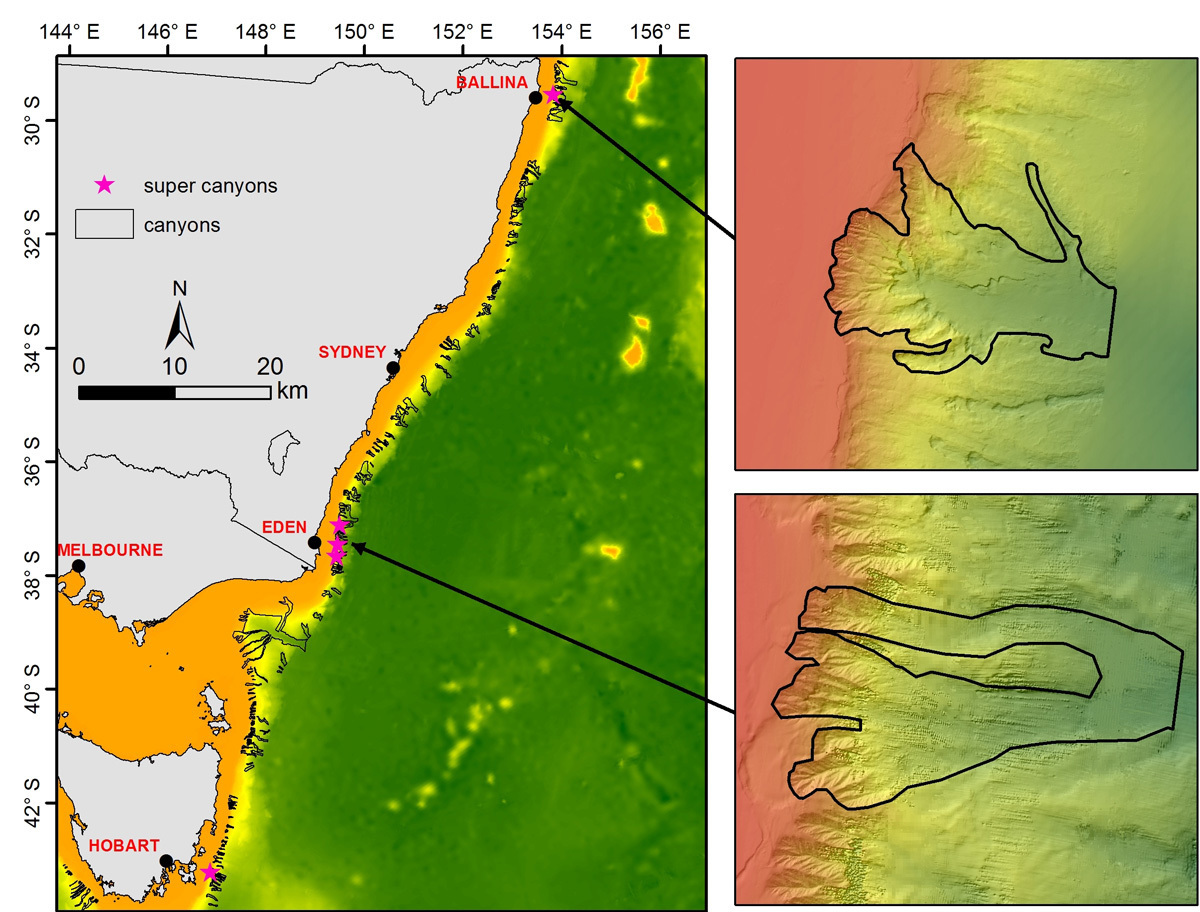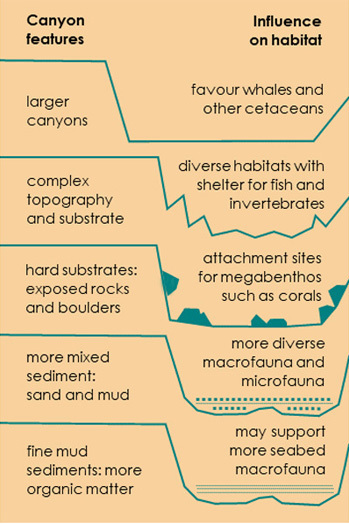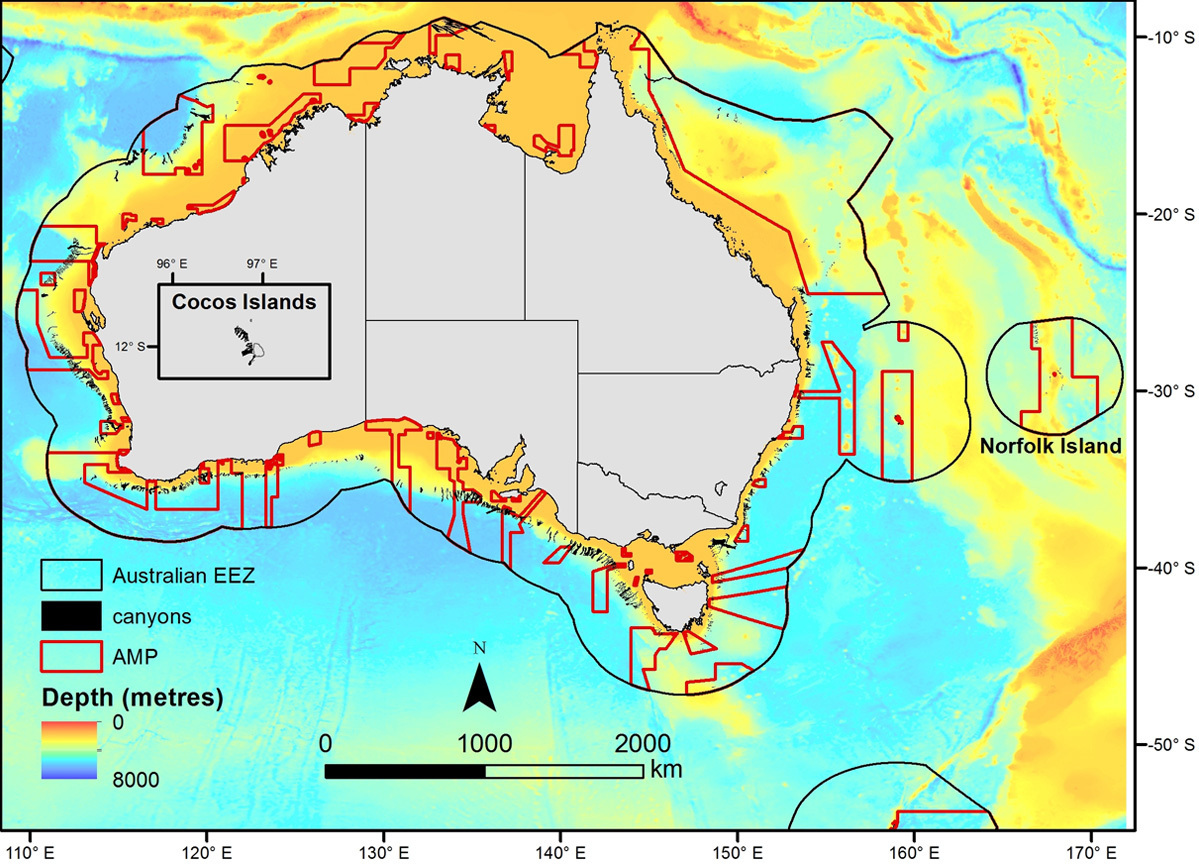May 7, 2018

Five submarine ‘super canyons’ have been identified off eastern Australia in a study that matched canyon environments with the needs of marine life.
Submarine canyons are steep-sided valleys cut into the sea floor that trap nutrients and attract a diversity of marine life. They funnel nutrient rich waters up onto the continental slope and shelf, fuelling feeding grounds for fishes, whales and other cetaceans. Communities of sponges and corals grasp their hard walls, and the tiniest of creatures collect in their sediments.
Australia has more than 750 submarine canyons. Most of these are in the south, and many are in Australian marine parks, or form key ecological features (areas of exceptional ecological value). All these canyons have now been rated for their habitat potential, in a Marine Biodiversity Hub study led by Geoscience Australia. This is the first time that the physical variability of Australian submarine canyons has been related to likely habitats and marine communities. To visit all the canyons would have taken forever, so how were the super canyons picked out from their counterparts?
Linking canyon features and marine life
Rather than going to sea, the research team scoured previous studies for links between canyon features and marine life (see the table). Using this knowledge they developed and applied an analytical framework for estimating the potential of individual canyons to support pelagic (open ocean) and benthic (seabed) species, including bottom-dwelling fishes.
Four aspects of canyon habitats – shape, size, topography and substrate type – were of particular interest and could be gleaned from seabed mapping. Assessments of organic matter, inorganic nutrients, oxygen and chlorophyll-a (a sign of phytoplankton), and oceanographic factors such as currents, were used to rate levels of productivity. Based on the available information, 22 environmental features were analysed as signs of habitat potential.
Of the 753 Australian submarine canyons, 135 offer good habitat potential for at least one of the three marine species categories: 13 are good for pelagic species, 36 are good for epibenthic species, and 124 are good for infauna species. Most of these good potential canyons are located off the east coast, and some are in the south, including the Albany canyons off Western Australia. But only the super canyons have good habitat potential for all three communities.
Super canyons in the east
The five super canyons were located off the Great Barrier Reef and the New South Wales coast and had particularly high habitat potential for both pelagic (open ocean) and seabed animals. Next in the ranking were canyons east of Tasmania, in the Murray group off South Australia and the Albany group off southern coast of Western Australia.
Most of the super canyons have complex bottom topography, and are situated in narrow parts of the continental margin nearer to terrestrial nutrient sources and with bottom currents that deliver food particles and generate intermediate 'disturbance'. They also are brushed by the East Australia Current which, aided by frequent, wind-driven upwelling events, lifts nutrients from deeper waters towards the surface.
The results showed that in general, canyons that bite into the continental shelf tended to score higher in habitat potential than those confined to the slope. And overall, canyons provide a better neighbourhood for animals that live in the seafloor sediments than for those that live above them.
Canyons, marine parks and management
Canyons with good habitat potential that also intersect an Australian Marine Park are found mostly in the east. In the south-east and temperate east regions, 29 canyons lie partly within nine Australian Marine Parks, including Tasman Fracture, Freycinet, Flinders, Murray, Jervis, Hunter, East Gippsland, Lord Howe and Central Eastern.
The Great Barrier Reef marine park also offers protection to a high proportion of canyons with good habitat potential, with 30 canyons intersecting the park. In contrast, only two canyons from the south-west region and one from the north-west are classed as having good habitat potential.
The framework for assessing canyon habitat – once refined and validated with ecological data – can support conservation and management decisions, especially for high value canyons, such as the prioritisation of monitoring, which might focus in the east, and to a lesser degree the south.
Apart from the habitat potential of these canyons, however, little is known about them. Multi-disciplinary surveys and studies are needed to collect baseline environmental and biological information, and understand more about these important ecosystems.

Further reading
- Log in to post comments
